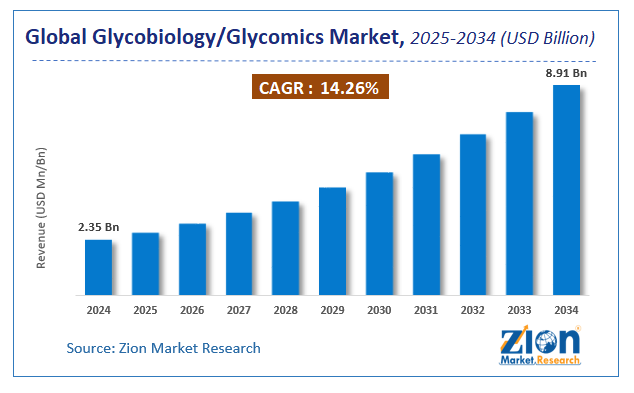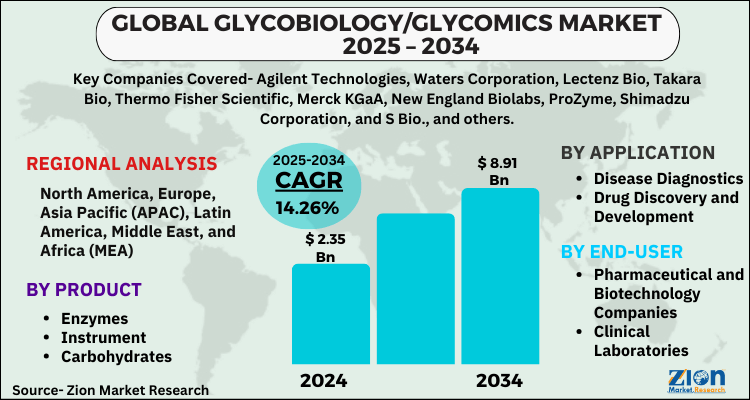Glycobiology/Glycomics Market Size, Share, Growth Analysis and Forecast 2034

Glycobiology/Glycomics Market By Product (Enzymes, Instrument, Carbohydrates, Kits, Reagents and Chemicals, Others), By Application (Disease Diagnostics, Drug Discovery & Development, Others), By End User (Pharmaceutical & Biotechnology Companies, Clinical Laboratories, Academic Research Institutes), and By Region - Global and Regional Industry Overview, Market Intelligence, Comprehensive Analysis, Historical Data, and Forecasts 2025 - 2034
| Market Size in 2024 | Market Forecast in 2034 | CAGR (in %) | Base Year |
|---|---|---|---|
| USD 2.35 Billion | USD 8.91 Billion | 14.26% | 2024 |
Glycobiology/Glycomics Market Size And Industry Analysis
The global glycobiology/glycomics market size was worth USD 2.35 Billion in 2024 and is estimated to grow to USD 8.91 Billion by 2034, with a compound annual growth rate (CAGR) of roughly 14.26% between 2025 and 2034. The report analyzes the glycobiology/glycomics market's drivers, restraints/challenges, and their effect on the demands during the projection period. In addition, the report explores emerging opportunities in the glycobiology/glycomics market.
Global Glycobiology/Glycomics Market: Overview
Glycomics, also known as glycobiology, studies the structure and function of saccharides found in nature and classified as glycans. Glycan can be found in a variety of species. Glycan is involved in innate immunity, cell regulatory pathways, protein interactions & folding, and cell shape modification. Glycobiology is a rapidly growing natural area with biotechnology, biomedicine, and research applications. After translation, most proteins in eukaryotic cells are changed. Glycan attachment is one of the most prevalent changes in living cells.
N-linked glycosylation, non-enzymatic glycosylated glycoproteins, and O-linked glycosylation are the three types of glycosylation. N-linked glycoproteins are involved in various biological activities, including cell-to-cell recognition, progression, differentiation, and apoptosis induction. The attachment of a sugar moiety to the oxygen atom of a protein's serine or threonine by-products is known as O-linked glycosylation.
Non-enzymatic glycosylation is the harsh chemical attachment of glucose to proteins that occurs when enzymes are not present. Glycobiology has several uses, including diagnostics, cancer, drug creation & development, immunology, and many more. Glycomics is a rapidly growing scientific discipline that focuses on identifying the key characteristics of glycan in biosystems.
Key Insights
- As per the analysis shared by our research analyst, the global glycobiology/glycomics market is estimated to grow annually at a CAGR of around 14.26% over the forecast period (2025-2034).
- Regarding revenue, the global glycobiology/glycomics market size was valued at around USD 2.35 Billion in 2024 and is projected to reach USD 8.91 Billion by 2034.
- The glycobiology/glycomics market is projected to grow at a significant rate due to increasing research in drug discovery and development, advancements in analytical techniques, and the growing understanding of glycans' role in various diseases and biological processes.
- Based on Product, the Enzymes segment is expected to lead the global market.
- On the basis of Application, the Disease Diagnostics segment is growing at a high rate and will continue to dominate the global market.
- Based on the End User, the Pharmaceutical & Biotechnology Companies segment is projected to swipe the largest market share.
- Based on region, North America is predicted to dominate the global market during the forecast period.
Glycobiology/Glycomics Market: Growth Drivers
Developing pharmaceutical and biopharmaceutical firm drives the market.
Technological investments and economic development are the primary reasons driving the global glycomics/glycobiology market. Other enterprises in the sector can benefit from developing countries' strategic advantages. Technological developments are supporting growth due to several government R&D initiatives and drug discovery by biotechnology and pharmaceutical corporations. Furthermore, participation in glycomics and proteomics research projects is rising, which is expected to boost market development throughout the forecast period. Increased sales of medicines used to treat some severe chronic conditions are also expected to stimulate glycomics/glycobiology growth.
Glycobiology/Glycomics Market: Restraints
Higher costs of maintenance and regulation hamper the market growth.
These procedures necessitate the acquisition of necessary components. Regulation and maintenance of these devices are also costly, which may limit the global glycomics/glycobiology market growth throughout the projection period. Bacterial glycomics research has created a novel medicine, glycoconjugate vaccines, and physiologically active glycan. The intrinsic intricacy of glycosylation, as well as its thorough structural examination, is a difficult subject. Technological advancements in glycomics technologies have enabled researchers to understand the importance of glycan in biology, and this trend is expected to continue during the forecast period.
Glycobiology/Glycomics Market: Segmentation
The global glycomics/glycobiology market is segregated based on products, applications, end-user, and regions.
Based on product, the market is segmented into enzymes, instruments, carbohydrates, kits, reagents, and chemicals. Because of their widespread use in drug development and diagnostic testing, instruments commanded the biggest market share. Furthermore, repeated purchases of reagents and kits are projected to drive segment expansion. Because of advances in cancer therapies and detection, enzymes are expected to account for a sizable market share shortly. Glycomics employs a variety of research methods to quantify or characterize the glycomics of a tissue, cell, or organism. Changes in the location or activity of enzymes involved in glycan biosynthesis result in changes in the final glycan structure. As a result, in addition to genetic markers, glycans may be studied to detect environmental changes.
Based on application, the market is classified into disease diagnostics, drug discovery & development, and others. In 2021, drug discovery & development held the biggest market share. This is largely due to considerable R&D and increased government financing for glycomics and proteome research. Other applications are expected to grow faster throughout the projected period, owing to increased clinical trials and R&D costs invested by significant firms for research.
Based on end-user, the market is segmented into pharmaceutical & biotechnology companies, clinical laboratories, and academic research institutes. Academic research institutes accounted for the greatest revenue share in 2021 due to increasing R&D spending. Collaborations between large corporations and research institutes are also helping to expand the industry. Due to increased R&D spending in drug discovery and development and other glycobiology-based studies, the pharmaceutical and biotechnology sector is expected to grow at the fastest CAGR during the projection period.
Glycobiology/Glycomics Market: Regional Landscape
North America dominates the glycobiology/glycomics market.
North America is predicted to be the fastest growing region in the global glycomics/glycobiology market throughout the forecast period. Increased investments in glycomics research, expanded pharmaceutical R&D investment potential for medicine development, and the presence of all main market rivals. North America is expected to dominate the worldwide glycomics market, followed by Europe. Most of North America's share is accounted for by the presence of all important firms, growing funding for glycomics research, expanding R&D spending for pharmaceutical discovery & development, and the presence of all key players. Because of significant pharmaceutical and biopharmaceutical businesses such as Merck KGaA, Agilent Technologies, Danaher, and Thermo Fisher Scientific, North America accounted for the greatest market share in 2021. The regional market has been pushed by well-established healthcare infrastructure and access to innovative goods. Furthermore, government support for R&D activities is a major driver driving glycobiology market expansion in this area.
Due to untapped market prospects, Asia Pacific is predicted to be the second-fastest growing regional market throughout the projection period. The region's glycomics industry has grown dramatically as a result of the region's developing pharmaceutical and biopharmaceutical sectors. Furthermore, Contract Research Organizations (CROs) investments in drug discovery and biologics manufacturing are likely to drive growth in the Asia Pacific glycomics market.
Glycobiology/Glycomics Market: Report Scope
| Report Attributes | Report Details |
|---|---|
| Report Name | Glycobiology/Glycomics Market |
| Market Size in 2024 | USD 2.35 Billion |
| Market Forecast in 2034 | USD 8.91 Billion |
| Growth Rate | CAGR of 14.26% |
| Number of Pages | 247 |
| Key Companies Covered | Agilent Technologies, Waters Corporation, Lectenz Bio, Takara Bio, Thermo Fisher Scientific, Merck KGaA, New England Biolabs, ProZyme, Shimadzu Corporation, and S Bio., and others. |
| Segments Covered | By Product, By Application, By End User, and By Region |
| Regions Covered | North America, Europe, Asia Pacific (APAC), Latin America, The Middle East and Africa (MEA) |
| Base Year | 2024 |
| Historical Year | 2020 to 2023 |
| Forecast Year | 2025 - 2034 |
| Customization Scope | Avail customized purchase options to meet your exact research needs. Request For Customization |
To know more about this report, request a sample copy.
Glycobiology/Glycomics Market: Competitive Landscape
The report provides a company market share analysis to give a broader overview of the key market players. In addition, the report also covers key strategic developments of the market, including acquisitions & mergers, new product launches, agreements, partnerships, collaborations & joint ventures, research & development, and regional expansion of major participants involved in the glycobiology/glycomics market on a global and regional basis.
Some of the main competitors dominating the global glycobiology/glycomics market include -
- Agilent Technologies
- Waters Corporation
- Lectenz Bio
- Takara Bio
- Thermo Fisher Scientific
- Merck KGaA
- New England Biolabs
- ProZyme
- Shimadzu Corporation
- S Bio.
Global Glycobiology/glycomics Market is segmented as follows:
By Product
- Enzymes
- Instrument
- Carbohydrates
- Kits
- Reagents and Chemicals
- Others
By Application
- Disease Diagnostics
- Drug Discovery and Development
- Others
By End-User
- Pharmaceutical and Biotechnology Companies
- Clinical Laboratories
- Academic Research Institutes
By Region
- North America
- The U.S.
- Canada
- Mexico
- Europe
- France
- The UK
- Spain
- Germany
- Italy
- Rest of Europe
- Asia Pacific
- China
- Japan
- India
- Australia
- South Korea
- Rest of Asia Pacific
- The Middle East & Africa
- Saudi Arabia
- UAE
- Egypt
- Kuwait
- South Africa
- Rest of the Middle East & Africa
- Latin America
- Brazil
- Argentina
- Rest of Latin America
Table Of Content
Methodology
FrequentlyAsked Questions
The global glycobiology/glycomics market is expected to grow due to growing applications in cancer and infectious disease studies, increasing research in drug discovery and biomarker development, advancements in glycan analysis technologies, and rising investments in pharmaceutical and biotechnology sectors.
According to a study, the global glycobiology/glycomics market size was worth around USD 2.35 Billion in 2024 and is expected to reach USD 8.91 Billion by 2034.
The global glycobiology/glycomics market is expected to grow at a CAGR of 14.26% during the forecast period.
North America is expected to dominate the glycobiology/glycomics market over the forecast period.
Leading players in the global glycobiology/glycomics market include Agilent Technologies, Waters Corporation, Lectenz Bio, Takara Bio, Thermo Fisher Scientific, Merck KGaA, New England Biolabs, ProZyme, Shimadzu Corporation, and S Bio., among others.
The report explores crucial aspects of the glycobiology/glycomics market, including a detailed discussion of existing growth factors and restraints, while also examining future growth opportunities and challenges that impact the market.
RelatedNews
HappyClients
Zion Market Research
Tel: +1 (302) 444-0166
USA/Canada Toll Free No.+1 (855) 465-4651
3rd Floor,
Mrunal Paradise, Opp Maharaja Hotel,
Pimple Gurav, Pune 411061,
Maharashtra, India
Phone No +91 7768 006 007, +91 7768 006 008
US OFFICE NO +1 (302) 444-0166
US/CAN TOLL FREE +1 (855) 465-4651
Email: sales@zionmarketresearch.com
We have secured system to process your transaction.
Our support available to help you 24 hours a day, five days a week.
Monday - Friday: 9AM - 6PM
Saturday - Sunday: Closed






